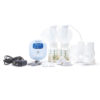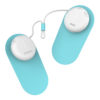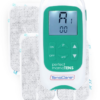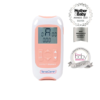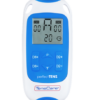Summer Vacation Tips for Travelling While Pumping
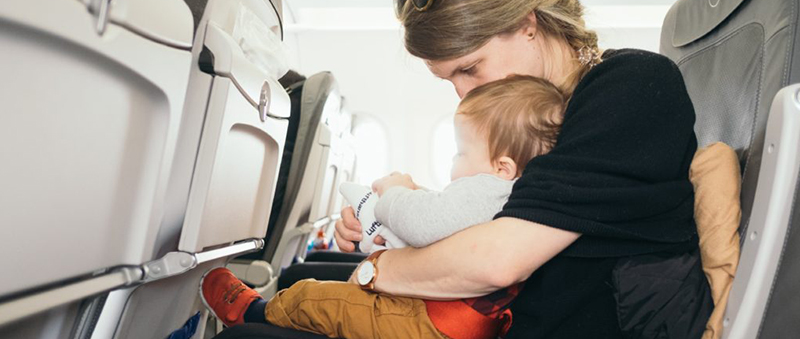
Summer Vacation Tips for Travelling While Pumping
Summer has finally arrived and for many of us, it’s the perfect time for a family getaway. But whether that means staying local and enjoying the outdoors with a hike or day trip, or something more adventurous, like a cross-country road trip – travelling as a new mom can seem daunting and overwhelming. Don’t let the fear of pumping or breastfeeding while travelling deter you from satisfying your wanderlust and enjoying your summer.
Here are a few tips we put together for travelling with your small baby or newborn.
It may sound obvious, but when we step out of our regular routine, things can go a bit haywire and basics can get overlooked. It’s not unusual for a baby’s schedule to change when you’re away from home and you may notice that they want to nurse or be fed more than usual. This is normal. Try to avoid too much handling and over-stimulation to reduce the chance of them becoming overtired and cranky. And if you’re heading to a hot climate, make sure you stay hydrated and baby stays cool.
Self care is key. Schedule plenty of time for relaxing and unwinding for both you and your baby. Even the most enjoyable trip can be tiring with a baby. Pay careful attention to your own needs for nutritious food, plenty of liquids, and rest.
If your trip involves air travel, be sure to pack a spare set of clothes in your carry-on for both you and baby in case your luggage gets delayed or there are unexpected spills or accidents. Choose a travel outfit that includes a loose-fitting top and have a light blanket or nursing poncho that you can use for privacy in tight quarters (if that’s what you prefer). This will help make breastfeeding or pumping during your flight feel much less overwhelming. For pre-flight, read up on the latest airport security rules regarding trasnporting breast milk for the applicable check points, whether it be USA or Canada.
Your baby may feel some temporary discomfort during the plane’s descent as the air pressure changes. Sucking (or more specifically, swallowing) may relieve this discomfort, as it helps the ears to ‘pop’. If possible, breastfeed during take off and landing. As an alternative, you may wish to offer a pacifier, bottle, or sippy cup. If you have an older child, hard candy (e.g. lollipop), chewing gum, or jerky can help alleviate the pressure. Air travel can also be dehydrating, so remember to drink plenty of water.
For our pumping moms, here are a few things you can do to reduce the stress and make your trip more enjoyable:
Create a “pumping kit”
Use an extra-large resealable bag and include a clean towel, dish soap, disinfecting wipes, bottle cleaners, and spare pumping parts. The wipes and towel will allow you to create a clean surface to lay your freshly washed pump parts no matter where you end up. Also, a washable marker for labelling the lid with the date is helpful.
Plan for a fridge at your destination
If you are staying with friends and family this shouldn’t be a problem, but you still may want to give them a heads up of what space you’ll need. If you’re staying in a hotel, call ahead to ensure your room comes with a mini fridge. Most hotels will provide one on request if it isn’t standard in the room, though it may be an additional charge. Many hotels will often waive the fee since breast milk is considered a medical liquid.
Breast milk will normally stay fresh in the refrigerator for up to 8 days maximum. Generally, it’s best not to freeze your milk during travel as once thawed, it needs to be consumed very quickly.
Important: Breast milk that has been frozen and has thawed needs to be used within 24 hours. For safety reasons, you cannot refreeze breast milk.
Good storage bottles, freezer packs, and a cooler are essential
For travel, skip the storage bags and instead opt for bottles with seal-able lids. If bottles aren’t available, you can use any hard plastic or glass container. Just ensure that whatever you use is clean (wash with hot, soapy water, rinse well, and air dry) and tightly sealed. Glass bottles can add quite a bit of weight, so if you do decide to use storage bags, wrap them in a towel or newspaper to avoid tears and leaks.
When stored in a cooler with ice packs, your milk should stay fresh for up to 24 hours. If travelling by car, choose an electric cooler that can be plugged into the power outlet of your car.
Note: If you’re travelling by air, freeze your ice packs to solid to reduce the potential for further screening through security. Also, keep your breast milk separate from your other allowable liquids.
Portion your breast milk
It’s a good idea to divide your milk into small amounts (2 to 4-ounce portions per container), so you have single servings available and don’t end up wasting precious breast milk should your baby only want a snack. If you’re freezing your milk, leave about an inch of room at the top of each container to allow for expansion.
Invest in a hands-free pumping bra
This could very well be some of your best money spent, other than on the breast pump itself. A hands-free pumping bra means that you won’t be tied down for every pumping session. Whether you’re in the car, on a plane, or in your hotel room you’ll have the ability to read, relax, or care for your child all while you pump. You are also able to massage your breast while you are pumping to help increase milk production.
Choose a bra that connects in the front for easy accessibility and has front openings for the breast pump flanges to fit. It should also work with any breast pump, and keeps the flange(s) snug on your breast, freeing up your hands to do what ever you like.
Safely Preparing and Storing Expressed Breast Milk
• Wash your hands before expressing or handling breast milk.
• When collecting milk, store it in clean containers such as screw cap bottles, hard plastic cups with tight caps, or storage bags.
• Clearly label your milk with the date it was expressed.
• Preferably, breast milk should be refrigerated or chilled immediately after it’s expressed.
• Do not add fresh breast milk to previously frozen milk. It is best not to mix the two.
• Do not save milk from a used bottle for use at another feeding.
• Have extra breast pump parts and keep used parts together in a bag to be washed at the end of the day. This will reduce the amount of time you spend washing. Do not reuse unwashed parts.
Safely Thawing Breast Milk
• If you have time, thaw frozen breast milk by transferring it to the refrigerator or by swirling it in a bowl of warm water. For air travel, ask the flight attendant for a cup of hot water.
Avoid using a microwave oven to thaw or heat bottles of breast milk
• Microwave ovens do not heat liquids evenly. Uneven heating could easily scald a baby or damage the milk
• Bottles may explode if left in the microwave too long.
• Excess heat can destroy the nutrient quality of the expressed milk.
Important: Do not re-freeze breast milk once it has been thawed.
Milk Storage Guidelines |
|||
Where |
Temperature |
Time |
Comments |
At room temperature (fresh milk) |
66° to 78° F (19° to 26° C) |
4 hours (ideal) up to 6 hours (acceptable)* |
Contents should be covered and kept as cool as possible; covering the container with a damp towel may keep milk cooler. |
Insulated cooler bag |
5° -39° F (-15° -4° C) |
24 hours |
Keep ice packs in constant contact with milk containers; limit opening cooler bag. |
In a refrigerator |
<39° F (<4° C) |
72 hours (ideal) up to 8 days (acceptable)** |
Collect in a very clean way to minimize spoilage. Store milk in the back of the main body of the refrigerator. |
Freezer (compartment of refrigerator) |
5° F (-15° C) |
2 weeks |
Store milk away from sides and toward the back of the freezer where temperature is most constant. Milk stored longer than these ranges is usually safe, but some of the fats break down over time. |
Freezer (compartment of refrigerator with separate doors) |
0° F (-18° C) |
3 – 6 months |
|
Deep Freezer |
-4° F (-20° C) |
6 – 12 months |
|
* refrigerate or chill milk right after it is expressed, unless you are using it right away.
** Eight days is acceptable if collected in a very clean, careful way.
***Adapted from LLL.org

